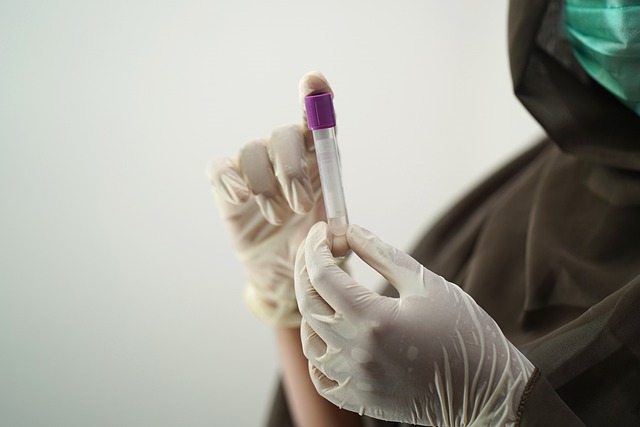The Male Hormone Blood Test UK is a key diagnostic tool within the UK healthcare system for assessing liver health in males. It measures testosterone and other androgen levels, which can indicate liver function and potential pathologies such as hepatic adenomas or haemangiomas. Elevated hormone levels may also result from reduced albumin production due to liver dysfunction, leading to increased free testosterone. These tests are crucial for early detection and management of liver conditions by revealing signs of impairment that might otherwise be missed. While these tests provide valuable insights, they must be part of a comprehensive clinical evaluation alongside other diagnostic methods. This multifaceted approach ensures accurate patient diagnosis and treatment planning, considering factors like overall health status, lifestyle, and additional clinical data. In the UK, standard liver function tests are complemented by the Male Hormone Blood Test UK to offer clinicians a broader understanding of hepatic health, particularly in conditions like cirrhosis or hepatocellular carcinoma. These tests, which include measures of AST, ALT, ALP, and GGT, help monitor the liver's synthetic and detoxification capabilities. Abnormal hormone levels can signal liver disorders or endocrine issues, reflecting the interplay between liver disease and endocrine system impacts. Healthcare professionals interpret these results within a patient's clinical context, using knowledge of hepatic and endocrine physiology to tailor management strategies, ensuring comprehensive care informed by an understanding of both systems' functions and interactions. This holistic approach is supported by UK medical guidelines, emphasizing the importance of accurate diagnosis and effective disease management.
Identifying liver dysfunction is a pivotal aspect of healthcare, necessitating precise diagnostic tools. This article delves into the standard liver function test, a critical evaluation tool for medical professionals, with a focus on its application and interpretation in the context of UK clinical practice. It also explores the intersection of male hormone blood tests and liver health, highlighting their importance in accurate diagnosis and patient care. Understanding these interrelated factors equips clinicians with the knowledge to navigate the complexities of hepatic assessment and endocrine profiling.
- Understanding the Standard Liver Function Test: An Overview for Medical Professionals
- The Role of Male Hormone Blood Tests in Liver Health Assessment
- Interpreting Results and Clinical Implications of Liver Function and Male Hormone Levels in the UK Context
Understanding the Standard Liver Function Test: An Overview for Medical Professionals

The standard liver function test is a critical diagnostic tool used by medical professionals to assess the health and functionality of the liver. This test includes a series of measurements that provide insight into the liver’s performance, including biochemical markers such as alanine aminotransferase (ALT), aspartate aminotransferase (AST), alkaline phosphatase (ALP), gamma-glutamyl transferase (GGT), total bilirubin, albumin, and globulin. These markers can indicate whether the liver is processing waste products properly or if there are any abnormalities in its functions. For instance, elevated levels of ALT and AST may suggest liver cell damage or inflammation, while high ALP can point to bile duct problems or bone disorders. In the UK, the Male Hormone Blood Test, which measures testosterone levels alongside liver function markers, can be particularly relevant for diagnosing conditions such as hypogonadism that may affect liver enzyme levels and vice versa. This integrated approach allows for a more comprehensive evaluation of liver health and its interplay with hormonal balance. Understanding the nuances of these tests is crucial for healthcare providers to accurately diagnose, monitor, and manage liver diseases and their comorbidities, ensuring optimal patient care. Medical professionals in the UK are equipped with guidelines and protocols that facilitate the correct interpretation of these tests, thereby enabling early detection and intervention for liver ailments.
The Role of Male Hormone Blood Tests in Liver Health Assessment

In the assessment of liver health, male hormone blood tests play a pivotal role, particularly in the UK context where they are integral to diagnosing and monitoring liver conditions in males. These tests measure levels of testosterone and other androgens, which can be affected by liver dysfunction. For instance, liver disease can impair the liver’s ability to produce albumin, a protein that binds to sex hormones, leading to increased free testosterone levels. Conversely, elevated male hormone levels may suggest liver pathology, such as hepatic adenomas or haemangiomas. These tests are crucial for early detection and management of liver-related issues in men, as they can indicate subtle changes in liver function that other diagnostic methods might miss.
The interpretation of results from a male hormone blood test UK requires careful consideration by healthcare professionals. It is not merely a matter of comparing values against set reference ranges. The context of the patient’s overall health, lifestyle factors, and other clinical findings must be taken into account. For example, low testosterone levels can be associated with various conditions, including liver disease, but they may also result from other factors such as ageing or hypogonadism. Thus, while male hormone blood tests are a valuable tool in the evaluation of liver health in men, they should be integrated with other diagnostic approaches and clinical judgement to provide a comprehensive assessment of a patient’s condition.
Interpreting Results and Clinical Implications of Liver Function and Male Hormone Levels in the UK Context

In the UK, standard liver function tests are pivotal in assessing hepatic health and are often complemented by male hormone blood tests, particularly when evaluating conditions such as liver cirrhosis or hepatocellular carcinoma. The results of these tests provide insight into the liver’s synthetic and detoxification capabilities. Aspartate aminotransferase (AST) and alanine aminotransferase (ALT) levels are key indicators of liver function, with elevated values suggesting hepatocellular injury or dysfunction. Alkaline phosphatase (ALP) and gamma-glutamyl transferase (GGT) further refine the interpretation, indicating bile duct patency and overall liver health, respectively. The integration of male hormone blood tests UK, specifically testosterone and luteinising hormone (LH), can offer additional clinical insights. For instance, abnormal levels of these hormones may indicate a liver disorder or an underlying endocrine condition such as hypogonadism, which can affect testosterone production. In the context of liver disease, changes in male hormone levels can also reflect the progression of the disease and its impact on the body’s endocrine system. Clinicians must consider these results within the broader clinical picture, including patient history, to accurately interpret their significance and tailor appropriate management strategies. The interplay between liver function and male hormone levels is complex and can be influenced by a multitude of factors, including age, lifestyle, and comorbidities. Thus, healthcare professionals in the UK must utilise a holistic approach when evaluating these tests, ensuring that patient care is informed by a comprehensive understanding of both hepatic and endocrine physiology.
In summary, this article has provided a comprehensive overview of the standard liver function test, its significance in clinical practice, and the interplay between male hormone levels as assessed by blood tests within the UK healthcare setting. For medical professionals, understanding these tests is paramount for diagnosing and managing liver conditions and associated hormonal imbalances. The integration of male hormone blood tests into liver health assessment offers a nuanced approach to patient care, allowing for more precise evaluation and treatment plans. As evidenced by the clinical implications discussed, this multifaceted analysis is invaluable in optimizing patient outcomes and informing decisions regarding therapeutic interventions. Medical Professionals must leverage these tools effectively to maintain high standards of liver health assessment in the UK.
